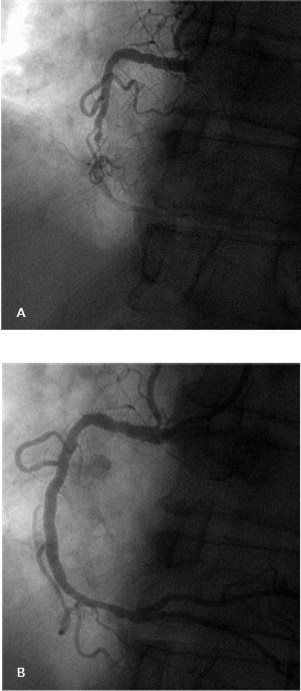Kosin Med J.
2018 Dec;33(2):235-239. 10.7180/kmj.2018.33.2.235.
Mallory-Weiss Tear After Cardiopulmonary Resuscitation in a Patient Suffering From Acute Myocardial Infarction
- Affiliations
-
- 1Department of Internal Medicine, Yangsan Pusan National University School of Medicine, Korea. plusmed2143@gmail.com
- KMID: 2430740
- DOI: http://doi.org/10.7180/kmj.2018.33.2.235
Abstract
- A report of a 79 year old male patient suffering from acute myocardial infarction with Mallory-Weiss tear after successful cardiopulmonary resuscitation(CPR) by emergency medical technician in the swimming pool is presented. Successful percutaneous coronary intervention(PCI) was done after appropriate transfusion. The patient survived and discharged without major complications after admitting 11days in the hospital. Importance of CPR in AMI patient is reiterated as complication such as Mallory-Weiss tear may arise.
MeSH Terms
Figure
Reference
-
1. Oh BJ, Hwang SO, Kim SW, Kang GH, Mun JB, Lee KH, Kim JM. Mallory-Weiss syndrome during cardiopulmonary resuscitation by an untrained bystander. J Korean Soc Emerg Med. 1999; 10:122–127.2. Sommers MS. Potential for injury: Trauma after cardiopulmonary resuscitation. Heart Lung. 1991; 20:287–295.3. Adler SN, Klein RA, Pellecchia C, Lyon DT. Massive hepatic hemorrhage associated with cardiopulmonary resuscitation. Arch Intern Med. 1983; 143:813–814.
Article4. Elliot DL, Goldberg L, Shlitt SC, Girard DE. Emphysematous cholecystitis following cardiopulmonary resuscitation. Arch Intern Med. 1984; 144:635–636.
Article5. Custer JR, Polley TZ Jr, Moler F. Gastric perforation following cardiopulmonary resuscitation in a child: report of a case and review of the literature. Pediatr Emerg Care. 1987; 3:24–27.
Article6. Spoormans I, Van Hoorenbeeck K, Balliu L, Jorens PG. Gastric perforation after cardiopulmonary resuscitation: review of the literature. Resuscitation. 2010; 81:272–280.
Article7. Reiger J, Eritscher C, Laubreiter K, Trattnig J, Sterz F, Grimm G. Gastric rupture--an uncommon complication after successful cardiopulmonary resuscitation: report of two cases. Resuscitation. 1997; 35:175–178.
Article8. Da Broi U, Moreschi C, Castellani M, Antonella B. Gastric mucosal tears and wall micro perforations after cardiopulmonary resuscitation in a drowning case. J Forensic Leg Med. 2009; 16:24–26.
Article9. Kinoshita Y, Furuta K, Adachi K, Amano Y. Asymmetrical circumferential distribution of esophagogastric junctional lesions: anatomical and physiological considerations. J Gastroenterol. 2009; 44:812–818.
Article10. Lundberg GD, Mattei IR, Davis CJ, Nelson DE. Hemorrhage from gastroesophageal lacerations following closed-chest cardiac massage. JAMA. 1967; 202:195–198.
Article
- Full Text Links
- Actions
-
Cited
- CITED
-
- Close
- Share
- Similar articles
-
- Mallory-Weiss Syndrome During Cardiopulmonary Resuscitation by an Untrained Bystander
- Thrombolytic Therapy during Cardiopulmonary Resuscitation in a Patient with Cardiac Arrest
- A Case of Gastric Rupture and Pneumoperitoneum after Cardiopulmonary Resuscitation in Acute Myocardial Infarction
- Cardiac arrest due to an unexpected acute myocardial infarction during head and neck surgery: A case report
- Endoscopic local injection of hypertonic saline-epinephrine solution in bleeding peptic ulcer or Mallory-Weiss tear



